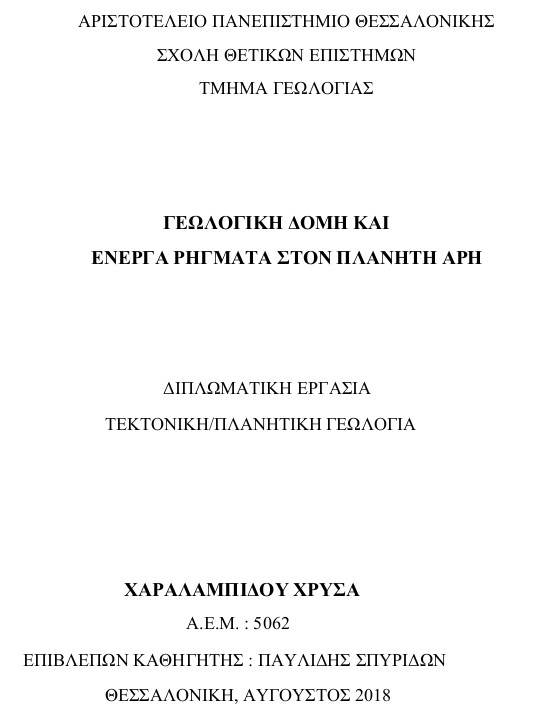
Γεωλογική δομή και ενεργά ρήγματα στον πλανήτη Άρη.
Περίληψη
Σκοπός αυτής της εργασίας είναι η ανάλυση της γεωλογικής δομής και της τεκτονικής δραστηριότητας του πλανήτη άρη. Στην πορεία αυτής της εργασίας έγινε λεπτομερείς παρουσίαση της πλανητικής γεωλογίας σαν επιστήμη και μία σύντομη αναφορά στο έργο του eugene shoemaker. Στη συνέχεια δίνονται οι τρόποι γεωλογικής μελέτης κυρίως μέσω της φαασματομετρίας. Έπειτα αναλύθηκαν η γεωμορφολογικές ιδιαιτερότητες του πλανήτη Άρη καθώς και διάφορα γεωλογικά στοιχεία ξεκινώντας γενικά από τα αστρονομικά στοιχεία του άρη και συνεχίζοντας με τη γεωλογία, τεκτονική και σεισμικότητα. Στην συνέχεια με γνώμονα 3 εργασίες έγινε λεπτομερής παρουσίαση των στοιχείων, μεθόδων και αποτελεσμάτων που σχετίζονται με την ενεργό τεκτονική του και την δημιουργία παλαιοσεισμών και σεισμών σήμερα. Η εργασία κλείνει με την πρόταση μου για τον τρόπο διδασκαλίας των γεωλογικών χαρακτηριστικών του Άρη.Τέλος παρατίθεται ο επίλογος, με τον οποίο συμπεραίνεται πως ο καταλληλότερος πλανήτης για την διαβίωση του ανθρώπου είναι ο πλανήτης γη.
Λέξεις κλειδιά : πλανητική γεωλογία, χάρτης, Άρης, επιφάνεια, διαστημοσυσκευή, τεκτονική, ρήγμα
The purpose of this work is to analyze the geological structure and tectonic activity of the planet mars.In the course of this work, a detailed presentation of planetary geology as a science and a brief reference to eugene shoemaker's work was made. the methods of geological study are then given mainly through the spectrometry. Then we analyzed the geomorphological features of the planet Mars as well as various geological data starting from the astronomical elements of Mars and continuing with geology, tectonics and seismicity. then, based on 3 papers, a detailed presentation of the data, methods and results related to its active tectonics and the creation of old earthquakes and earthquakes was presented. The work ends with my suggestion on how to teach Mars' geological features. Finally, there is an epilogue, which concludes that planet earth is the most suitable planet for the living of man.
Keywords: planetary geology, map, Mars, surface, spacecraft, tectonic, fault
Πλήρες Κείμενο:
PDFΑναφορές
Βιβλία
• Andrew N. R., (1999), Manual of Remote Sensing, Remote Sensing for the Earth Sciences, vol 3, 509-550 pp (https://books.google.gr)
• Hauber, T.E., Jonas M., Voelker, Knapmeyer M., Grott M., Matz K.D. (2014), Fault scaling on Mars : slip distribution and displacemet-lenght relationship derived
from HRSC data, Συνέδριο σεληνιακής και πλανητικής επιστήμης. (https://www.hou.usra.edu/meetings/lpsc2014/pdf/1981.pdf)
• Golombek M. P., Banerdt B. W., Tanaka K. L., Tralli D. M., (1992) A prediction of Mars seismicity from surface fauliting, Science, vol 258 pp 979-981 (http://science.sciencemag.org)
• Greeley R., Bender K., Pappalard R., (1998) Planetary Geology A Teacher’s Guide with Activities in Physical and Earth Sciences, vol. 2 pp 51-75, vol. 4 pp. 127, vol. 5 pp 183-215 (https://www.nasa.gov/audience/foreducators)
• Steele A., Cubbin F.M., Fries M., Kater L., Boctor N. Z., Fogel M. L., Conrad P. G., Glamoclija M., Spencer M., Morrow A. L., Hammond M. R., Zare R. N., Vicenzi E. P., Siljestrom S., Bowden R., Herd C. D. K., Mysen B. O., Shirey S. B., Amundsen H. E. F., Treiman A. H., Bullock E. S., Ju;; A. J. T., (2012) A reduced carbon component in martian basalts, vol. 337 pp 212-215 (http://science.sciencemag.org)
• Wiley J. and sons, (1999), Remote Sensing for the Earth Sciences: Manual of Remote Sensing, American Society of Photogrammetry and Remote Sensing, vol 3, 509-564 pp, (http://marswatch.sese.asu.edu)
Ιστοσελίδες
• Bob Yirka, (2016), Chondrule evidence suggests ancient low-velocity collisions betwwen rocky planetesimals and icy bodies, Phys.org, (https://phys.org/news)
• Chapman M. G., USGS, Gene Shoemaker - Founder of Astrogeology (https://astrogeology.usgs.)
• Composition of Mars, (τελευταία επεξεργασία 21 Ιουλίου 2018) (https://en.wikipedia.org/wiki/Composition_of_Mars)
• Geology of Mars,(τελευταία τροποποίηση 23 Ιουνίου 2018) Wikipedia, (https://en.wikipedia.org)
• Fraser C. (2013), Universe today, (https://www.universetoday.com),
• Planetary geology, (τελευταία τροποποίηση 23/8/2006), Wikipedia, (https://en.wikipedia.org)
• Plesa A. C., Knapmeyer M., Golombek M. P., Grott M., Kawamura M., Longonne P., Tosi N., Weber R. C., (2018) Present‐Day Mars' Seismicity Predicted From 3‐D Thermal Evolution Models of Interior Dynamics, AGU 100, (https://agupubs.onlinelibrary.wiley.com)
• Roberts P. G., Matthews B., Bristow C., Guerrieri L., Vetterlein J., (2012), Possible evidence of paleomarsquakes from fallen boulder populations, Cerberus Fossae, Mars, AGU 100, (https://agupubs.onlinelibrary.wiley.com)
• Sharp T. (2017), How Far Away is Mars? | Distance to Mars, Space.com, (https://www.space.com)
• Tectonics of Mars (τελευταία τροποποίηση 3 Φεβρουαρίου 2018), Wikipedia (https://en.wikipedia.org)
• Witze A. (2018),Mars quakes set to reveal tantalizing clues to planet’s early years Nature, (https://www.nature.com)
Εισερχόμενη Αναφορά
- Δεν υπάρχουν προς το παρόν εισερχόμενες αναφορές.
